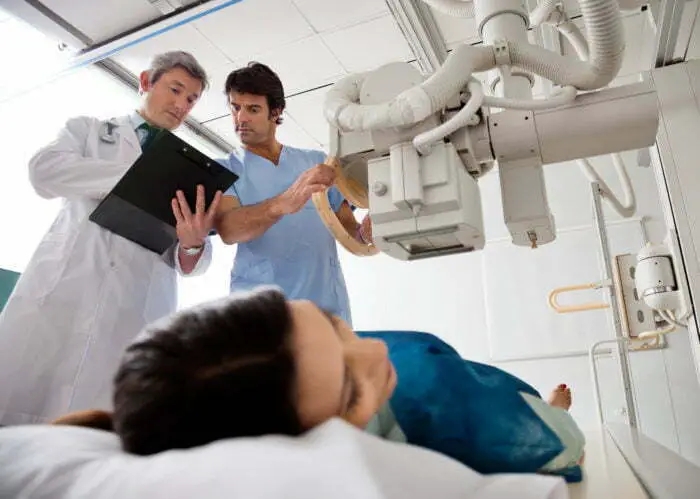X-Ray Tech

An X-Ray Tech is a radiologic technologist. X-ray technicians aid physicians and other medical personnel in diagnosing patients. They do this through the use of special equipment capable of capturing x-ray images of the body.
Technicians are responsible for positioning patients properly for x-rays. They are also responsible for ensuring the resulting images are of a high quality so the radiologist is able to assess the results and make a diagnosis for the patient.
Radiologic technology is a medical field that continues to grow every year. The U.S. Bureau of Labor Statistics (BLS) reports that radiology techs can expect an employment growth of nine percent between 2014 and 2024.
In This Article
What is an X-Ray Tech?
An x-ray technician is also known as a radiographer or radiologic technologist. These medical professionals perform x-rays and other similar diagnostic imaging tests on patients to help physicians diagnose and treat them. The x-ray tech uses his or her knowledge of diagnostic imaging equipment to perform the specific tests requested by a physician.
Before the tests, the x-ray technician sets up, maintains, and calibrates the imaging equipment. Once the tests are completed, the x-ray tech documents the findings and submits the results to the physician. They may also assist the physician in interpreting the results of the tests.
In addition to performing straight-forward x-rays, the x-ray technician may perform other diagnostic imaging exams on particular areas of the body to help diagnose specific diseases.
Areas of Specialization
Radiologic technologists can choose to not only be certified as radiographers but may also choose to specialize in certain types of radiography. Candidates may focus on one of the following areas of radiography:
- Mammography – a diagnostic image of the breast
- Magnetic Resonance Imaging (MRI) – a more detailed exam that uses magnetic fields and radio wave energy to take pictures of organs and smaller areas inside the body
- Computed Tomography (CT) – an imaging exam that uses specialized equipment to view bones, organs, blood vessels, and soft tissue
- Bone Densitometry – an exam that’s similar to an x-ray but determines the density of bones
- Sonography – an imaging exam that uses high-frequency sound waves to view tissues, organs, and blood flow
- Vascular Sonography – a type of imaging that views internal organs and monitors blood flow through the veins and arteries
- Cardio-Interventional (CI) Radiography – an area of imaging that focuses on the heart and detects potential heart problems
- Breast Sonography – an area of imaging that uses high-frequency sound waves focused on the breast
To be eligible for certification in any of these areas, the radiographer must have completed a training program, within the previous three years that focuses on that specific area. The program will include didactic studies and clinical work so candidates can demonstrate proficiency in these areas. Obtaining multiple certifications can improve a radiographer’s employment opportunities and wage potential.
How Much Does an X-Ray Tech Make?
According to ZipRecruiter, on average x-ray techs make the following in each state.
| State | Annual Salary | Monthly Pay | Weekly Pay | Hourly Wage |
|---|---|---|---|---|
| Massachusetts | $50,839 | $4,237 | $978 | $24.44 |
| Hawaii | $50,227 | $4,186 | $966 | $24.15 |
| Connecticut | $49,827 | $4,152 | $958 | $23.96 |
| Tennessee | $48,921 | $4,077 | $941 | $23.52 |
| Minnesota | $48,704 | $4,059 | $937 | $23.42 |
| Ohio | $48,562 | $4,047 | $934 | $23.35 |
| Rhode Island | $48,359 | $4,030 | $930 | $23.25 |
| Washington | $48,155 | $4,013 | $926 | $23.15 |
| New York | $47,637 | $3,970 | $916 | $22.90 |
| North Dakota | $47,541 | $3,962 | $914 | $22.86 |
| Utah | $47,516 | $3,960 | $914 | $22.84 |
| Alaska | $47,514 | $3,960 | $914 | $22.84 |
| Louisiana | $47,233 | $3,936 | $908 | $22.71 |
| Nevada | $47,139 | $3,928 | $907 | $22.66 |
| South Dakota | $46,154 | $3,846 | $888 | $22.19 |
| Maryland | $46,060 | $3,838 | $886 | $22.14 |
| New Hampshire | $45,991 | $3,833 | $884 | $22.11 |
| Iowa | $45,941 | $3,828 | $883 | $22.09 |
| Oregon | $45,573 | $3,798 | $876 | $21.91 |
| Nebraska | $45,247 | $3,771 | $870 | $21.75 |
| Kansas | $45,086 | $3,757 | $867 | $21.68 |
| Kentucky | $44,665 | $3,722 | $859 | $21.47 |
| Virginia | $44,653 | $3,721 | $859 | $21.47 |
| California | $43,546 | $3,629 | $837 | $20.94 |
| South Carolina | $43,432 | $3,619 | $835 | $20.88 |
| Colorado | $43,382 | $3,615 | $834 | $20.86 |
| Vermont | $43,264 | $3,605 | $832 | $20.80 |
| Delaware | $43,070 | $3,589 | $828 | $20.71 |
| Wyoming | $42,704 | $3,559 | $821 | $20.53 |
| Mississippi | $42,258 | $3,521 | $813 | $20.32 |
| Oklahoma | $42,053 | $3,504 | $809 | $20.22 |
| West Virginia | $41,408 | $3,451 | $796 | $19.91 |
| Pennsylvania | $41,207 | $3,434 | $792 | $19.81 |
| New Jersey | $41,051 | $3,421 | $789 | $19.74 |
| Arkansas | $40,832 | $3,403 | $785 | $19.63 |
| Idaho | $40,806 | $3,401 | $785 | $19.62 |
| Michigan | $40,687 | $3,391 | $782 | $19.56 |
| Montana | $40,627 | $3,386 | $781 | $19.53 |
| Illinois | $40,611 | $3,384 | $781 | $19.52 |
| Maine | $40,559 | $3,380 | $780 | $19.50 |
| Arizona | $40,209 | $3,351 | $773 | $19.33 |
| Indiana | $39,951 | $3,329 | $768 | $19.21 |
| Wisconsin | $39,932 | $3,328 | $768 | $19.20 |
| Missouri | $39,715 | $3,310 | $764 | $19.09 |
| Texas | $39,421 | $3,285 | $758 | $18.95 |
| Georgia | $38,788 | $3,232 | $746 | $18.65 |
| New Mexico | $37,926 | $3,161 | $729 | $18.23 |
| Alabama | $37,882 | $3,157 | $728 | $18.21 |
| North Carolina | $37,011 | $3,084 | $712 | $17.79 |
| Florida | $36,559 | $3,047 | $703 | $17.58 |
How Long Does It Take to Become an X-Ray Tech?
About 2 years.
X-Ray technicians need an associate’s degree to become certified. Associate’s degrees typically take two years to attain. As a radiologic technologist, you can specialize in one of many other medical imaging specialties including MRI and Sonography.
Where Do X-Ray Techs Work?
Although x-ray techs may work in medical and diagnostic laboratories, physicians’ offices, or outpatient care centers, the majority work in hospitals. They spend a lot of time on their feet and may be required to assist in moving, lifting, and turning patients to obtain the maximum accuracy in the results.
Most x-ray technicians work during business hours; however, many are called into work during the evenings and weekends to perform diagnostic imaging tests in emergencies. X-ray techs are required to wear protective clothing such as gloves, badges, and aprons to minimize their exposure to radiation.
How to Become a Certified X-Ray Tech
Effective January 1, 2015, radiologic technologists or radiographers must have at least an associate’s degree from an AART accredited school. One of the most common agencies that accredit ARRT schools and programs is the Joint Review Committee on Education in Radiologic Technology (JRCERT). Radiography programs must include general education courses and radiography-related courses. The student must also show competency in various clinical procedures as dictated by the ARRT.
Another major part of the curriculum in a radiography program is a clinical internship. The internship allows students to obtain hands-on training performing radiography procedures. Students wishing to focus on specific areas of radiography must complete courses and obtain certification in those specific areas of study.
Certification Requirements
Although most states do not license their radiographers, they do require x-ray techs to be certified or registered. This can be accomplished by meeting the following requirements:
- Complete an ARRT-approved degree program in radiography
- Meet the ethics requirements set by the ARRT
- Pass the certification exam administered by the ARRT within three years of completion of the program
For purposes of licensing, 37 US states use the ARRT certification exam. The certification exam is a computer-based test that is mostly multiple-choice questions and a few case study questions. Becoming a certified or registered radiographer involves successful completion of three areas: education, ethics, and examination.
Merely having experience or completing a training program is not enough. The final phase is passing the certification exam, and eligibility to take the certification exam is contingent on the candidate meeting both the education and ethics requirements set by the ARRT.
X-Ray Tech School
Students who have obtained their education while in the military may also obtain certification as radiographers if they meet the ARRT requirements. An individual may not need a degree in radiologic science to meet the degree requirement. If the candidate has a degree from a program that’s approved by the ARRT, he or she may be eligible to complete a radiography training program and obtain certification.
Sponsored Programs
The College of Health Care Professions , Online
Location - Mcallen, TX, US 78504The College of Health Care Professions is a Texas-based career education school founded by physicians in the Texas Medical Center solely specializing in healthcare education and dedicated to provid... Read More
ProgramsLimited Medical Radiologic Technologist with MA Skills - Certificate
Technological Changes Experienced by the X-Ray Tech
The x-ray tech role has experienced many changes in recent decades. These changes involve not only the educational and training requirements but also the terminology used to describe this medical profession.
Before the 1960s, a radiographer was referred to as an x-ray technician, x-ray tech, or x-ray technologist. Even today the terms technicians and technologists are often used interchangeably, even though they have different training requirements and responsibilities according to the American Registry of Radiologic Technologists® (ARRT).
In the past, x-ray technicians may have been hired with little or no training and received on-the-job training. Additionally, when aspiring technologists did complete education, it may have been only a certificate or a one-year program. Today, a technologist or radiographer must complete a two-year ARRT-accredited training program that results in a degree.
What About Continuing Education?
ARRT certification must be renewed annually. To maintain certification and registration, the technologist must complete continuing education credits. X-ray technologists must show proof of at least 16 hours of structured education every two years to maintain certification and registration. Individuals who are not currently employed as radiographers but in need of recertification may find ARRT-approved schools that offer radiologic science courses that meet the continuing education requirements.
MRI Vs. X-ray
MRI scans vary from X-Ray scans significantly. Not only do they vary in the technology used, but also in their availability and usefulness. Learn the difference in MRI vs xray.

